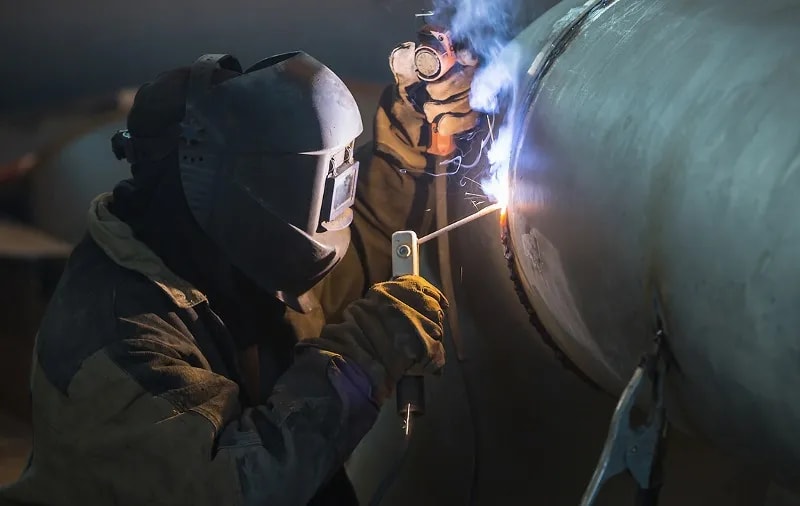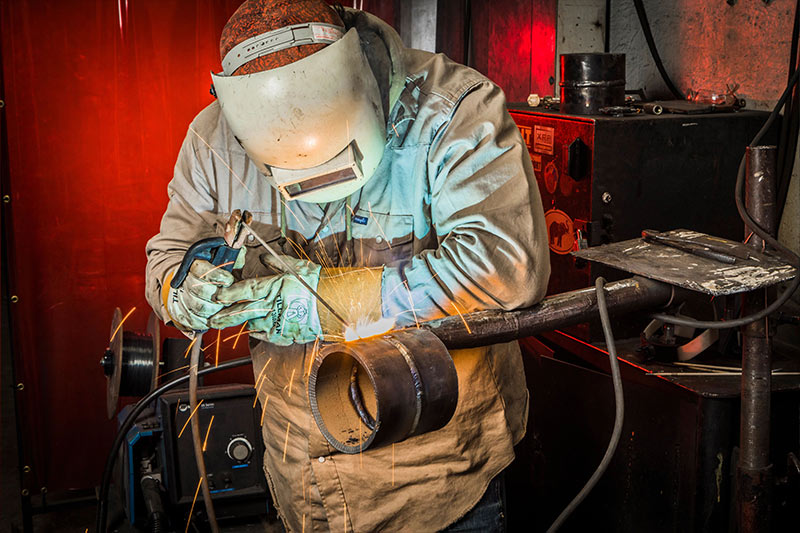Everything about Welding: Secret Insights Into Techniques and Best Practices for Success
Welding incorporates a range of strategies, each suited for specific products and applications. Understanding these techniques, such as GMAW, SMAW, and TIG, is vital for attaining ideal results. Moreover, the right equipment and security methods can not be neglected. As prep work and troubleshooting play important functions in the welding procedure, understanding these elements can significantly improve the quality of the final item. What are the vital elements that ensure an effective weld?
Comprehending Different Welding Techniques
Welding techniques encompass a range of techniques, each matched to details applications and products. Amongst the most common strategies are Gas Steel Arc Welding (GMAW), Secured Steel Arc Welding (SMAW), and Tungsten Inert Gas Welding (TIG) GMAW, additionally known as MIG welding, is preferred for its speed and adaptability, making it perfect for slim materials. SMAW, or stick welding, is preferred for its simpleness and effectiveness in outdoor atmospheres, especially with thicker steels. TIG welding offers accuracy and control, making it ideal for intricate work and non-ferrous metals (Welding). Each method has its special benefits and considerations, allowing welders to select the very best approach based on the task's requirements, product type, and desired results. Comprehending these strategies is vital for effective welding
Vital Welding Tools and Devices
While numerous welding techniques require particular skills, the right equipment and tools are just as necessary for attaining top quality outcomes. Crucial welding tools includes welding makers, which differ relying on the strategy-- such as MIG, TIG, or stick welding. Safety equipment, consisting of handwear covers, safety helmets, and aprons, assurances safety and convenience throughout the procedure. On top of that, fixtures and clamps aid protect products in place, ensuring precision in welds. Consumables like welding rods, cord, and securing gas are also critical elements that affect the top quality of the weld. Additionally, tools such as grinders and cutters facilitate surface area prep work and post-weld finishing, adding to a professional end result. Buying top quality equipment inevitably improves the efficiency and effectiveness of welding jobs.
Security Practices in Welding
Appropriate safety and security methods are necessary in the welding industry to safeguard workers from possible dangers. Welders must wear suitable personal safety equipment (PPE), including safety helmets with proper shading, handwear covers, and flame-resistant clothes. Sufficient ventilation is important to decrease exposure to damaging fumes and gases generated throughout the welding process. Furthermore, employees ought to be educated in the correct handling of welding devices to avoid mishaps. Fire precaution, such as keeping flammable materials far from the welding area and having fire extinguishers conveniently offered, are required. Routine examinations of tools and work areas can assist determine prospective hazards before they lead to accidents. By sticking to these security methods, welders can produce a more secure working atmosphere and minimize threats linked with their profession.
Readying Products for Welding
Preparing products for welding is a vital step that substantially influences the top quality and integrity of the end product (Montana Mobile Welding and Repair Belgrade). Appropriate prep work includes cleansing the surface areas to eliminate pollutants such as dirt, corrosion, and oil, which can jeopardize the weld. Methods such as grinding, sanding, or making use of solvents are commonly used to achieve a clean surface. Additionally, making certain that the products mesh well is vital; spaces can lead to weak welds. It's additionally important to take into consideration the placement and positioning of the parts, as this will certainly influence the convenience of welding and the final end result. Lastly, picking the proper filler product and guaranteeing compatibility with the base steels is important for achieving solid, resilient welds
Tips for Getting High-Quality Welds
Accomplishing top notch welds needs focus to information and adherence to best methods throughout the welding procedure. Correct joint preparation is crucial, guaranteeing surface areas are tidy and complimentary from contaminants. Choosing the suitable filler material and welding technique based upon the base metals is vital for excellent bonding. Preserving consistent travel speed and angle while welding can advertise and prevent problems harmony. Furthermore, regulating warmth input is crucial; extreme heat can cause warping and weakened joints. Routinely evaluating the welds during the process permits for prompt changes if necessary. Lastly, using ideal post-weld treatments, such as cleaning and tension relief, can improve the longevity and stability of the weld, ultimately making sure an effective result.
Troubleshooting Common Welding Issues
Welding frequently provides difficulties that can impact the high quality and honesty of the final item. Common concerns such as porosity, inconsistent weld beads, and overheating can occur, each calling for details troubleshooting methods. Recognizing these issues is important for welders to enhance their abilities and achieve ideal outcomes.
Porosity Troubles Explained
Although porosity can usually be neglected, it stays an important concern in welding that can compromise the stability of an ended up product. click site Porosity refers to the existence of small gas pockets within the weld bead, which can lead and weaken the joint to premature failing. This trouble generally arises from impurities, moisture, or inappropriate securing gas insurance coverage during the welding procedure. To reduce porosity, welders need to verify that the base products are clean and completely dry, use ideal protecting gases, and keep regular welding specifications. Frequently inspecting the tools and atmosphere can likewise help recognize potential problems before they manifest in the weld. Resolving porosity successfully Your Domain Name is crucial for attaining solid, resilient welds that fulfill high quality criteria.

Inconsistent Weld Beads
Inconsistent weld beads can considerably impact the quality and stamina of a finished product. Numerous aspects add to this concern, consisting of inappropriate travel speed, inaccurate amperage setups, and irregular electrode angles. When the welder relocates also quickly, a bead may appear slim and lack infiltration, while moving too gradually can trigger too much accumulation. In addition, using the wrong amperage can lead to either damaging or too much spatter, both of which concession weld integrity. The welder's strategy, such as irregular torch movement, can also bring about irregular grain look. To mitigate these troubles, welders ought to focus on keeping steady, regulated activities and making certain correct equipment settings to accomplish uniformity in their welds. Consistency is essential to achieving dependable and solid welds.
Overheating and Bending Issues
Extreme warm throughout the welding process can lead to considerable overheating and deforming issues, influencing the architectural honesty of their explanation the work surface. These troubles commonly show up as distortion, which can endanger placement and fit-up, making more assembly challenging. Factors adding to overheating include the choice of welding parameters, such as voltage and take a trip rate, along with the sort of material being welded. To minimize these issues, welders should keep consistent travel speed and appropriate heat input while keeping an eye on the work surface temperature. Furthermore, pre-heating or post-weld warm therapy can aid relieve stress and anxieties triggered by fast air conditioning - Belgrade. Normal assessment and adherence to ideal methods are important in preventing overheating and making certain the durability and reliability of bonded structures
Often Asked Questions
What Are the Profession Opportunities in the Welding Industry?
The welding sector uses varied occupation opportunities, consisting of positions as welders, examiners, educators, and designers. Professionals can operate in manufacturing, building and construction, aerospace, and auto sectors, gaining from solid demand and competitive incomes in numerous duties.
Exactly How Can I Improve My Welding Speed Without Giving Up Top Quality?
To improve welding speed without giving up top quality, one ought to practice efficient strategies, keep tools, maximize setups, and boost hand-eye control. Normal training and looking for feedback can also substantially add to attaining faster, high-grade welds.
What Certifications Are Readily Available for Welders?
Various qualifications exist for welders, including those from the American Welding Culture (AWS), the National Facility for Construction Education and Research Study (NCCER), and different industry-specific companies. These qualifications improve employability and demonstrate skill proficiency.
Just How Does Welding Affect the Features of Metals?
Welding affects the buildings of steels by modifying their microstructure, which can result in modifications in ductility, stamina, and solidity. Heat input and air conditioning prices throughout the procedure substantially affect these material features.
Can I Bonded Dissimilar Metals With Each Other?
